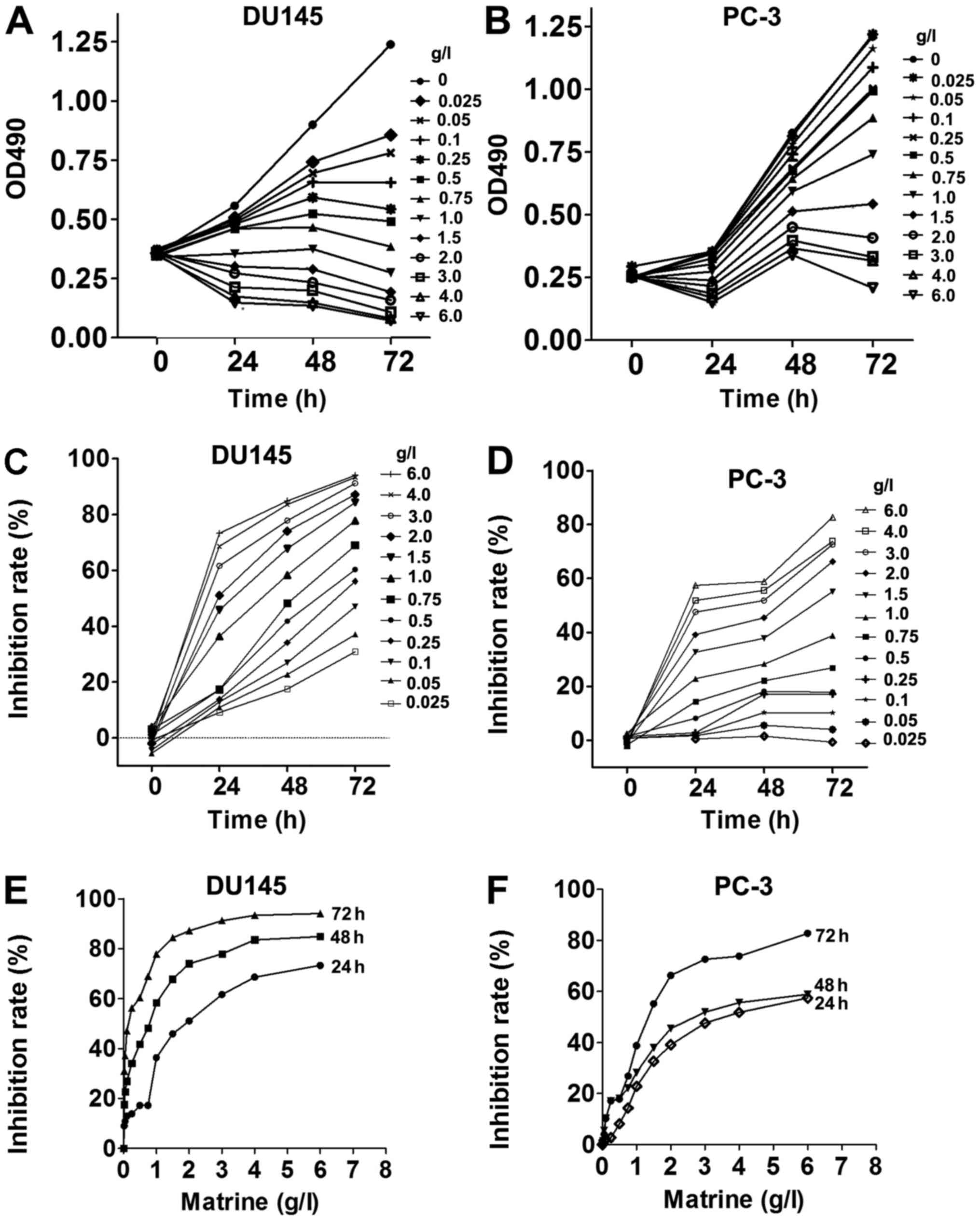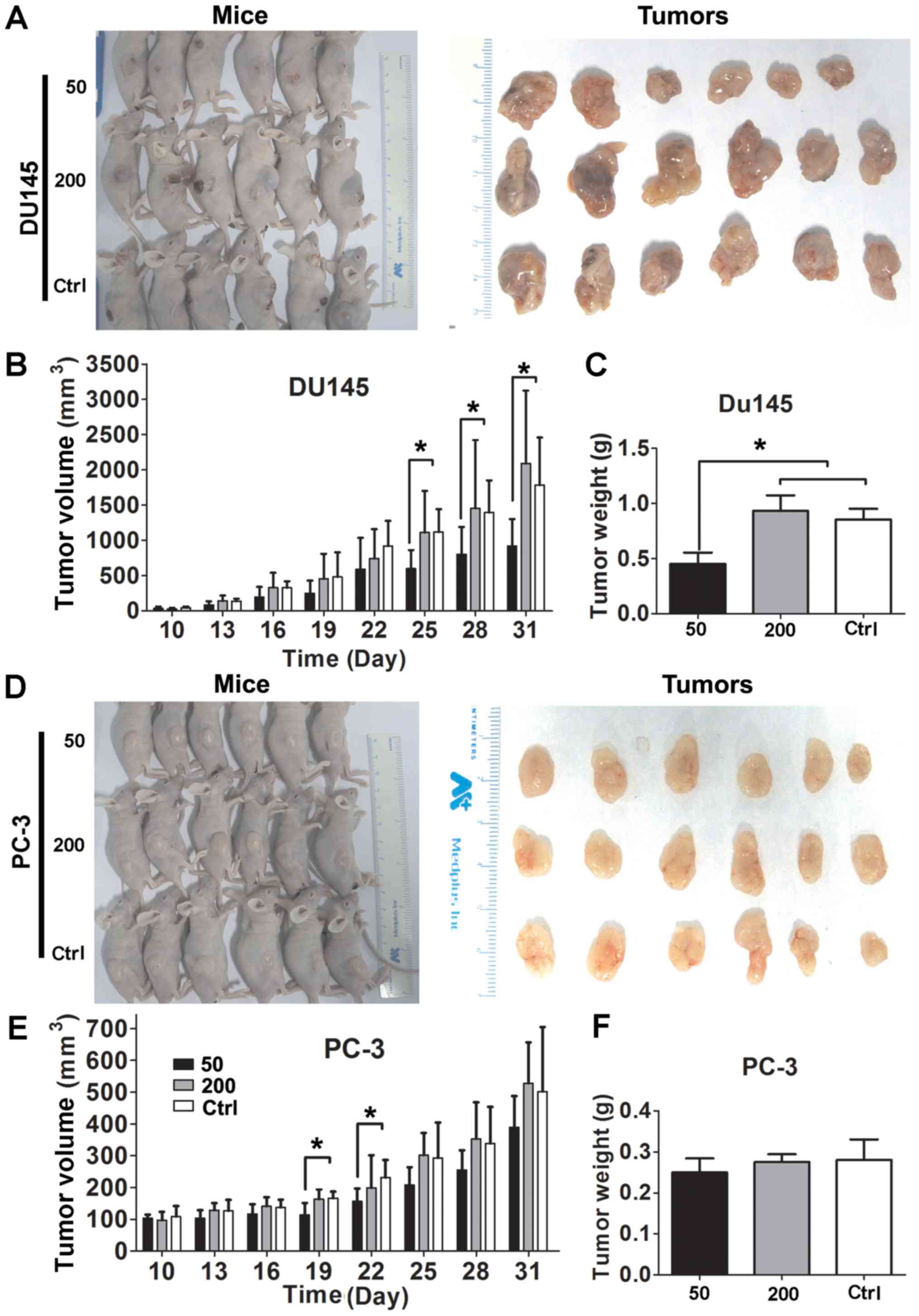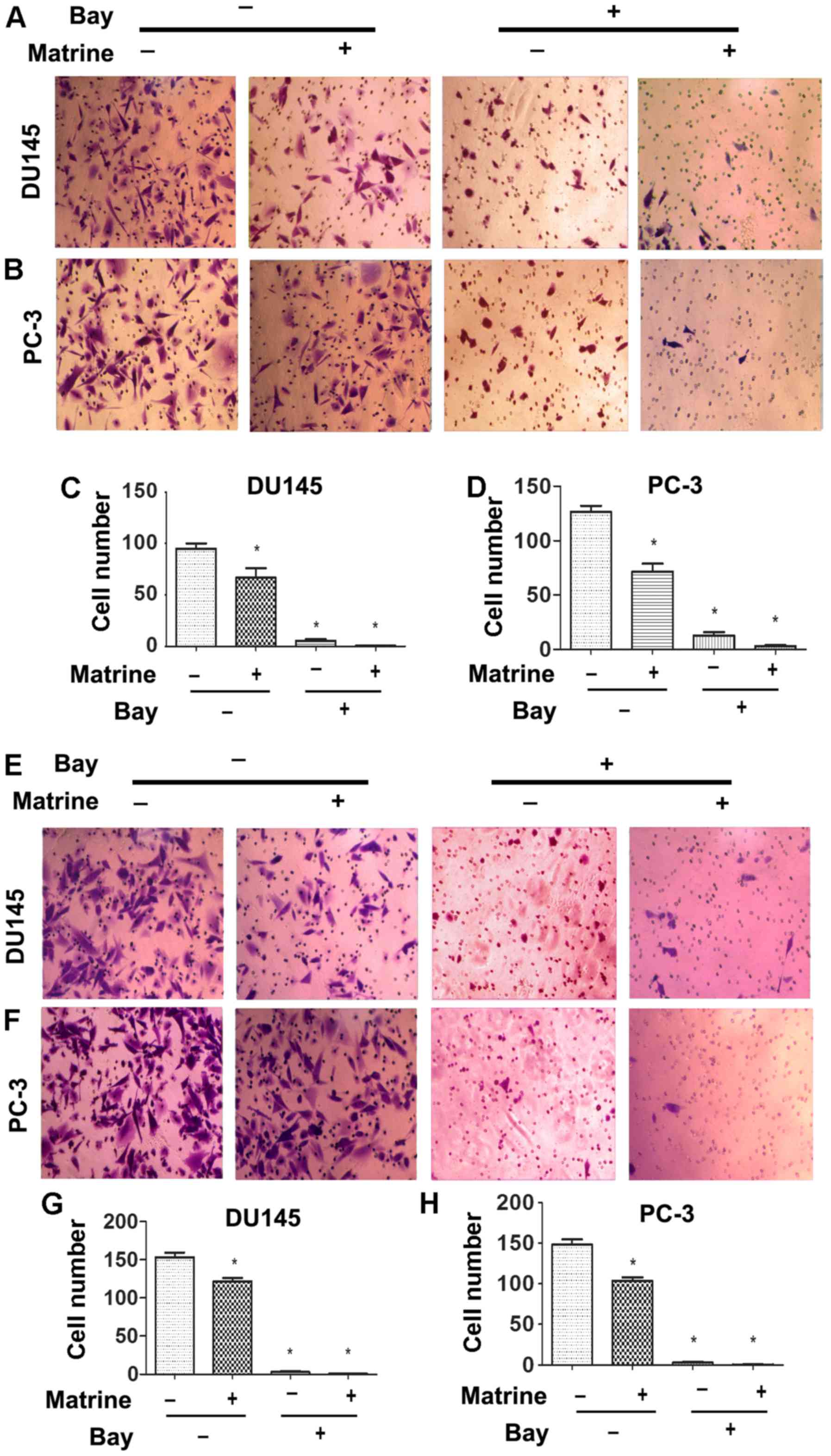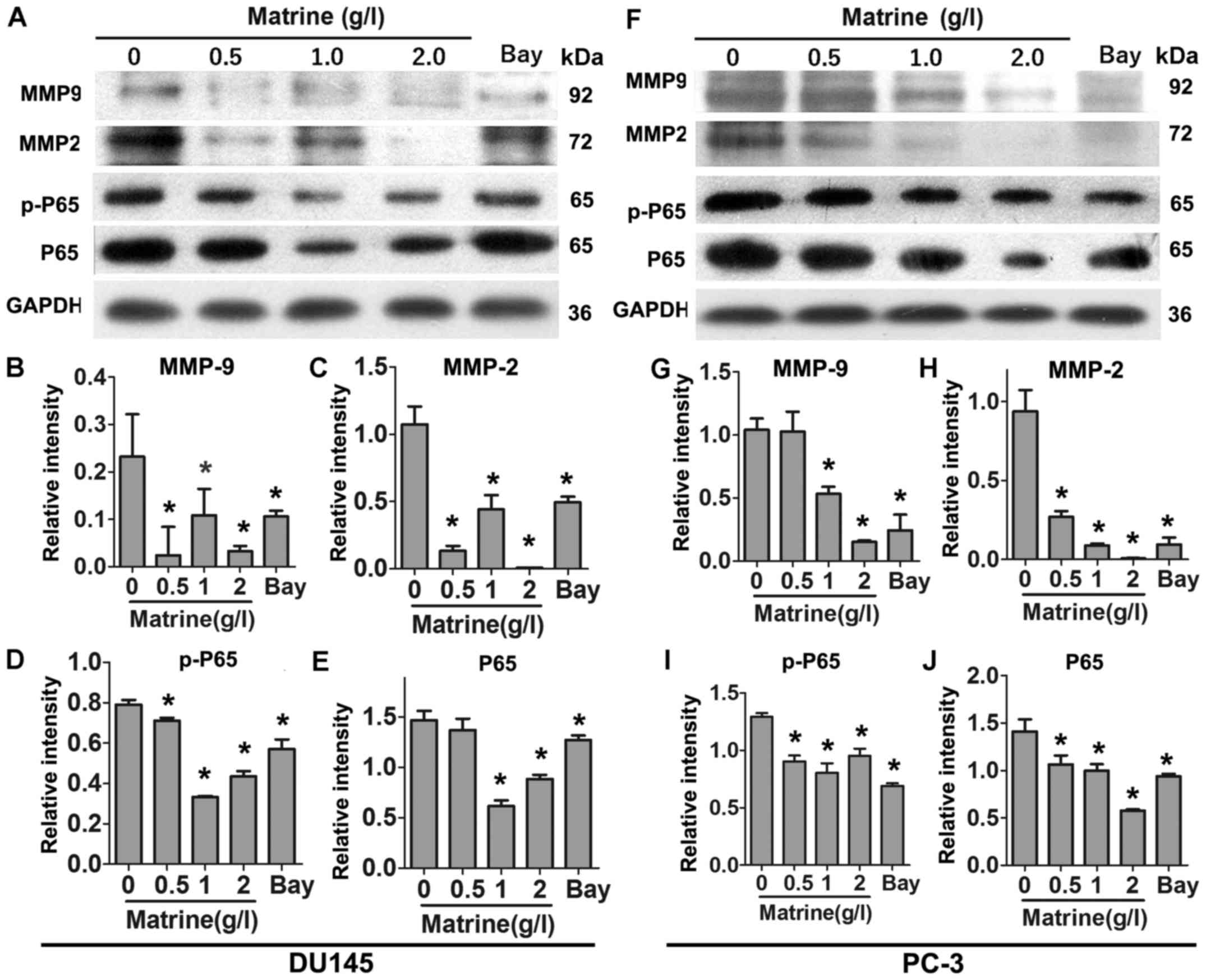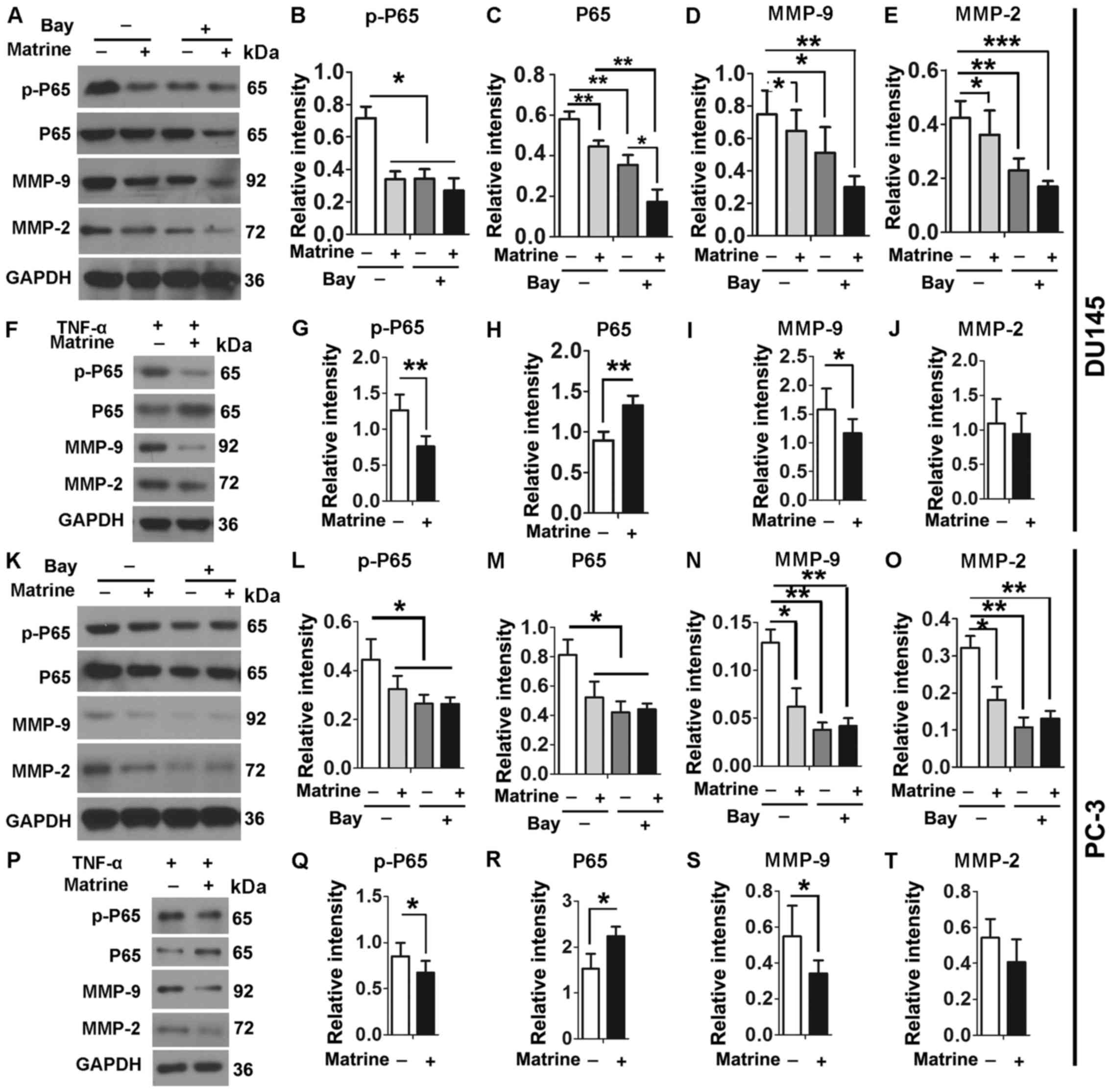Matrine suppresses invasion of castration-resistant prostate cancer cells by downregulating MMP-2/9 via NF-κB signaling pathway
- Authors:
- Published online on: December 14, 2016 https://doi.org/10.3892/ijo.2016.3805
- Pages: 640-648
Abstract
Introduction
Prostate cancer (PCa) is one of the most common malignancies for men (1). Most PCa depends on androgens for growth and survival, and androgen ablation therapy represents the most effective initial treatment (2). Unfortunately, most PCa will progress to castration-resistant prostate cancer (CRPC) with higher potential of invasion and metastasis in 2–3 years (3). Though efforts have been made for treating CRPC for years, an efficient therapeutic treatment is still not available (4). Therefore, identification of mechanisms involved in CRPC carcinogenesis and metastasis may be the key to novel treatments.
Tumor metastasis is a crucial hallmark of cancer progression. It involves numerous factors including defects in programmed cell death, degradation of the extracellular matrix (ECM) and tumor angiogenesis (5). ECM provides structural support to cells and tissues by heterogeneous macromolecules and is a rich source of angiogenesis promoters (6). Matrix metalloproteases 9 and 2 (MMP-9 and MMP-2) catalyze the degradation of essentially the majority of ECM and components of the basement membrane and proteolytically cleave and activate precursors of angiogenesis promoters, which play an important role for tumor invasion and metastasis (7–10). The degradation activities of MMP-9 and MMP-2 are regulated by NF-κB activity (11,12).
Matrine (C15H24N2O), an alkaloid derived from Sophora flavescens, a traditional Chinese herb medicine, has been identified to exhibit bioactive and pharmacological effects such as anti-inflammatory (13) and antiviral activities (14). It also exhibits an anticancer effect on malignancies such as lung cancer, breast cancer and castration-sensitive prostate cancer (15–17). In our previous study, we have identified the inhibitory abilities of matrine for growth of CRPC cells through NF-κB signaling pathway in vitro (18). However, the anti-metastatic effects of matrine on CRPC in vivo and the underlying mechanisms regulating NF-κB by matrine are still unknown.
In this study, we proved that matrine reduced the growth and invasion abilities of CRPC cell lines both in vitro and in vivo by reducing the expression levels of MMP-2 and MMP-9 via NF-κB signaling pathway. Our results imply that matrine may be developed as a novel anti-metastasis therapeutic drug for CRPC in future.
Materials and methods
Reagents
Matrine [chemical formula: C15H24N2O; molecular weight: 248.36] was purchased from Dalian Mellon (Dalian, China). Dulbecco's modified Eagle's medium (DMEM), fetal bovine serum (FBS), penicillin, streptomycin, phosphate-buffered saline, and RPMI-1640 media were purchased from Hyclone (Logan, UT, USA).
Cell lines and culture
Human castration-resistant prostate cancer cell lines DU145 and PC-3 were obtained from the cell bank of the Center for Experiment Animals of Sun Yat-sen University (Guangzhou, China). Cells were maintained in RPMI-1640 supplemented with 10% (vol/vol) FBS, 1% penicillin and streptomycin at 37°C in an incubator containing 5% CO2. Different concentrations of matrine were added into culture medium to treat cells for different times.
Cell viability assay
DU145 and PC-3 cells were seeded in 96-well plates (100 µl/well) at a density of 1×104 cells/well for 24 h. Then the cells were treated with various concentrations of matrine (0, 0.025, 0.05, 0.1, 0.25, 0.5, 0.75, 1.0, 1.5, 2.0, 3.0, 4.0 and 6.0 g/l). After incubation for 0, 24, 48 and 72 h, the viability of the cells was evaluated using the MTS kit (cellTiter96AQ, Promega Corp., Madison, WI, USA) according to the manufacturer's instructions, and the absorption was read at 490 nm.
Migration and invasion assay
The migration and invasion assays were performed using Transwell® Inserts (BD Biosciences, Bedford, MA, USA). Approximately 1×105 cells in 100 µl serum-free RMPI-1640 medium were placed in the upper chamber, and 600 µl RMPI-1640 medium containing 10% (vol/vol) FBS were placed in the lower chamber. For the invasion assay, Transwell® membranes were pre-coated with 25% Matrigel (BD Biosciences). The cells were then incubated for 48 h at 37°C in 5% CO2 with 0.5 g/l matrine, 10 µM Bay11-7082 (Bay), 0.5 g/l matrine plus 10 µM Bay or fresh median (the untreated control). Cells were fixed in 4% paraformaldehyde for 20 min and stained with 0.05% crystal violet in PBS for 10 min. The cells on the upper side of the filter were removed with cotton-tipped swabs, and the filter was washed with 1X PBS. The cells on the underside of the filter were examined and counted under a microscope with a power of ×200 magnification.
Western blotting
Cells treated with different concentrations of matrine, Bay and TNF-α (T6674 Sigma, USA) were lysed in a RIPA lysis buffer system (50 mM Tris-HCl, 1 mM EDTA, 150 mM NaCl, 0.5% sodium deoxycholate, 1% Triton X-100, 0.1% sodium dodecyl sulfate (SDS) and 1 mmol/l PMSF, pH 7.4). Supernatants were then collected via centrifugation at 14,000 × g for 15 min at 4°C. Proteins were separated by electrophoresis in 10% SDS-polyacrylamide gel and transferred onto polyvinylidene fluoride (PVDF) membranes (Millipore Corp., Billerica, MA, USA). PVDF membranes were incubated in blocking buffer (1X Tris-buffered saline, 0.1% Tween-20 with 5% non-fat dry milk) for 1 h and probed overnight at 4°C with specific primary antibodies against p-P65, P65, MMP-2, MMP-9 (1:1,000; Cell Signaling Technology, Beverly, MA, USA) or GAPDH (1:1,000; Kangcheng Biology, Shanghai, China). After being washed, membranes were incubated with horseradish peroxidase (HRP)-conjugated secondary antibody (Dako) for 1 h at room temperature. Membranes were subsequently visualized with the Western Blotting Luminal Reagent (Millipore Corp.) according to the manufacturer's protocol.
Animal xenograft model assays
Male Balb/c nude mice (5-weeks old) were purchased from Experimental Animal Center of Sun Yat-sen University (Certificate of compliance: 44008500010058; Guangzhou, China) and raised under specific pathogen-free (SPF) conditions. All experimental procedures were performed according to the institutional ethical guidelines approved by the Institutional Animal Care and Use Committee of Sun Yat-sen Memorial Hospital, Sun Yat-sen University. Suspensions of DU145 and PC-3 cells (0.1 ml 5×107 viable cells/ml) were subcutaneously injected into the right flank of mice. Nine days later, the tumor volumes were ~100 mm3 in all mice. The treatment and control groups were subjected to intraperitoneal injection of 50 or 200 mg/kg matrine and an equal volume of saline three times per week, respectively (6 mice in each group). Tumor sizes were measured twice weekly, and the volumes (cm3) were calculated according to the formula: V = (length × width2) / 2. Animals of both groups were sacrificed to measure tumor weights 3 weeks later.
Statistical analysis
All the experiments were repeated successfully at least three times. Two-tailed Student's t-test was used to determine the difference between groups by GraphPad Prism (San Diego, CA, USA). A P-value ≤0.05 was considered statistically significant.
Results
Matrine reduces the viability of DU145 and PC-3 cells in vitro
DU145 and PC-3 cells were exposed to increasing concentrations of matrine, and their viabilities were evaluated by MTS assays at different time-points. Matrine inhibited the proliferation of both CRPC cell lines in a dose- and time-dependent manner (Fig. 1A and B). The inhibition rates of both CRPC cell lines reached almost 90% when cells were treated with 6.0 g/l matrine for 72 h (Fig. 1C and D). The potency of matrine to suppress the growth of CRPC cells was increased with increasing time (Fig. 1E and F). Thus, matrine suppresses the viabilities of both CRPC cell lines DU145 and PC-3.
Matrine suppresses tumor growth in nude mice inoculated with CRPC cells
DU145 and PC-3 cells were inoculated into male Balb/c nude mice. The time courses of CRPC xenograft growth with and without matrine treatment are shown in Fig. 2. Inhibitory impacts of matrine on tumor volume and weight were observed in DU145-inoculated mice treated with 50 mg/kg/d matrine (Fig. 2A–C). Such impact of matrine on tumor growth was only observed on the 19th and 22nd days in PC-3-inoculated mice treated with 50 mg/kg/d matrine (Fig. 2D–F). Interestingly, matrine at dosage of 200 mg/kg/d did not show any impact on the tumor size and weight of either DU145- or PC-3-inoculated mice, we did notice that tumors in the sacrificed mice treated with high dosage of matrine started ulcerating. The results suggest that matrine may suppress the tumor growth of CRPC at low dose but exhibit no antitumor effect at high dose due to interruption of the homeostasis of mice.
Matrine reduces the ability of migration and invasion of CRPC cells
We further tested whether matrine has any effect on the migration and invasion of CRPC cells. Cells were untreated or treated with 0.5 g/l matrine to measure cell migration and invasion. The migration rates of both DU145 and PC-3 cells were significantly reduced when cells were treated with matrine for 48 h (Fig. 3A–D). Invasion assay with Transwell chambers coated with Matrigel indicated that the number of either DU145 or PC-3 cells that invaded to the lower chamber significantly decreased after cells were treated with matrine for 48 h (Fig. 3E–H). Therefore, matrine effectively impairs the ability of migration and invasion of CRPC cells.
Matrine reduces the expression levels of MMP-9 and MMP-2 and impairs NF-κB pathway in CRPC cells
Since MMPs play important roles in the invasion of cancer cells. We examined the expression levels of MMP-9 and MMP-2 in CRPC cells exposed to different concentrations of matrine by immunoblotting. Similar to NF-κB inhibitor Bay, matrine reduced the expression levels of MMP-9 and MMP-2 in DU145 cells in a concentration-dependent manner (Fig. 4A–C). NF-κB is reported as a key signaling molecule that mediates the expression of MMPs (11). We hypothesized that NF-κB signaling pathway might also be affected by matrine. As shown in Fig. 4A, D and E, the expression levels of p-P65 and P65 in DU145 cells were markedly downregulated upon treatment with matrine for 48 h. The same trends were observed in PC-3 cells (Fig. 4F–J). Collectively, these results demonstrate that matrine suppresses the expression of MMP-9 and MMP-2 and inactivates NF-κB signaling pathway in CRPC cells.
Matrine inhibits migration and invasion of CRPC cells by suppressing MMP-9 and MMP-2 through NF-κB pathway
In addition, NF-κB is involved in the control of migration and invasion of tumor cells. We hypothesized that the suppression of migration and invasion of CRPC cells may be caused by downregulation of NF-κB. Combined treatment of NF-κB inhibitor Bay and matrine caused a synergistic reduction in migration and invasion of both in DU145 and PC-3 cells (Fig. 3). We further investigated whether the inhibitory effects of matrine on cell invasion and expression of MMP-9 and MMP-2 were correlated with the inhibition of NF-κB pathway. Either DU145 or PC-3 cells were cultured in the absence or presence of 0.5 g/l matrine, 10 µM Bay and/or 10 ng/ml TNF-α for 48 h. Consistently, the levels of p-P65 and P65 proteins were significantly reduced when DU145 cells were treated with matrine and/or Bay (Fig. 5A–C). Consequently, the expression levels of MMP-9 and MMP-2 in DU145 cells were significantly reduced upon exposure to matrine and/or Bay (Fig. 5A, D and E). When NF-κB pathway was activated by TNF-α, matrine significantly reduced expression levels of p-P65 and MMP-9 in DU145 cells (Fig. 5F–J). However, expression levels of MMP-2 were not significantly changed when DU145 cells were cultured in the presence of both matrine and TNF-α, suggesting different regulatory mechanisms for MMP-9 and MMP-2. Similar results were obtained when the tested cell line was changed to PC-3 (Fig. 5K–T). Therefore, inhibitory effects of matrine on migration and invasion of CRPC cells act by reducing levels of MMP-9 and MMP-2 through the NF-κB pathway.
Discussion
Naturally-occurring phytochemicals play important roles in the prevention and treatment of cancers (19,20). As a naturally-occurring phytochemical, matrine has been reported to exhibit anticancer effects on different malignancies such as lung cancer, breast cancer, and castration-sensitive prostate cancer (15–17). In our previous study, we identified the inhibitory ability of matrine in CRPC cells in vitro. This study investigated the mechanisms of anti-metastatic effects of matrine against CRPC cells. Our data showed that matrine inhibited the viability of CRPC cells time- and dose-dependently. In vivo study further demonstrated that matrine inhibited the growth of CRPC tumors in nude mice. Transwell analysis showed that matrine also inhibited the migration and invasion of CRPC cells dose-dependently through NF-κB pathway. The underlying mechanism is potentially that suppressing NF-κB activities causes reduction in levels of MMP-9 and MMP-2. These data imply that matrine is a potent candidate for CRPC treatment.
PCa mainly depends on the presence of androgens for growth and survival, and blocking androgen secretion or activity represents the most effective initial treatment (2). However, after the initial surgical or medical ablation, most PCa will progress to CRPC stage with increased malignancy in 2–3 years and need for second-line therapy (3,21). Although cytotoxic drugs and recently approved drugs for more efficient blockade of androgen signaling are available, there is still a need for new and more efficient treatment strategies in CRPC (22). Matrine has been reported to inhibit the proliferation and invasion of different malignancies (23–25). This study initially investigated whether matrine had similar effects on CRPC. Results proved that matrine did reduce the viability of DU145 and PC-3 cells time- and dose-dependently. Moreover, matrine inhibited migration and invasion of the CRPC cells. These results may be translated into the development of novel treatment approach with matrine. To further confirm the hypothesis of such a novel treatment modality, we conducted in vivo analyses to demonstrate that matrine decreased the growth of tumor xenografts in nude mice inoculated with CRPC cells by inhibiting cell proliferation.
Tumor metastasis involves a complex process and various cellular physiological changes. Cancer cell invasion is the first step for metastasis, which is characterized by increasing cell motility caused by alterations in cell-cell and cell-ECM interactions (26). Apoptotic defects may cause cells to be resistant to cell death induced by such alterations, which may promote cancer cell invasion (27). Apoptosis is a type of programmed cell death that is characterized by cell membrane blebbing, cell shrinkage, nuclear fragmentation, chromatin condensation, and chromosomal DNA fragmentation (28). After initiating invasion, cancer cells undergo various stresses that may trigger apoptosis by the extrinsic and the intrinsic pathways (29). However, even with the successful micro-metastases, there is only ~0.01% of tumor cells that ultimately develop into macro-metastases in their destined organs. Such inefficiency may be closely related to the stress-induced apoptosis because of changed cell environment (30). Many small molecules targeting apoptotic pathways, such as ABT-263, and GX15-070, have been developed for cancer therapy (31). Other studies indicated that matrine exerts anticancer effects by inducing apoptosis in different malignancies such as cholangiocarcinoma, medulloblastoma and lung cancer (23–25). Studies also showed that matrine exhibits anti-metastatic effects by inducing apoptosis in lung cancer and breast cancer (16,32). Matrine induces apoptosis by decreasing the expression of Bcl-2 and increasing expression of Bax. Apoptosis may block metastatic dissemination by killing misplaced cells. Apoptotic resistance induced by the loss of cell-cell and cell-ECM contacts may promote metastatic progression (27).
The ECM is composed of heterogeneous macromolecules and provides structural support to cells. It stores rich angiogenesis promoters and inhibitors (6). The degradation or breakdown of the ECM is a critical step in tumor invasion, leading to the separation of the intercellular matrix to promote metastasis. MMPs, which are a family of structurally related zinc-dependent endo-peptidases, are collectively capable of degrading essentially all components of ECM including collagens, gelatin and proteoglycan (8,33). Among MMPs, MMP-2 and MMP-9 were reported to play the most important roles for cancer invasion and metastasis (34,35). Previous studies have reported that matrine can reduce the expression of MMP-2 and MMP-9 in tumor cells (32,36,37). NF-κB, promoting expression of MMP-2 and MMP-9, has previously been reported as a downstream target of matrine in cancer cells (32,36,37). Our study indicated that matrine significantly reduces the expression levels of MMP-2 and MMP-9, implying that matrine may inhibit the invasion of DU145 and PC-3 cells by downregulating the expression and activity of MMP-2 and MMP-9. Further analysis on the signaling pathway regulating MMP-2 and MMP-9 suggested that matrine significantly decreased the expression levels of NF-κB subunit p65 and p-p65 that are located within the nuclei of DU145 and PC-3 cells. All results indicated that NF-κB-MMP-2/9 is a key signaling pathway by which matrine regulates the invasive and metastatic abilities of CRPC cells.
In conclusion, this study provides evidence that matrine is capable of inhibiting the proliferation, migration and invasion of CRPC cells. The invasion is most likely inhibited by reducing expression levels of MMP-2 and MMP-9 through inactivation of NF-κB pathway. A novel potential therapeutic application of matrine for anti-metastatic therapy of CRPC is revealed.
Acknowledgments
This study was supported by the National Natural Science Foundation of China (nos. 81472382 and 81672550), the National Natural Science Foundation of China for Young Scientists Grant (no. 81101947), the Guangdong Province Natural Science Foundation (no. 2014A030313079), the Fundamental Research Funds for the Central Universities (no. 14ykpy19), the Guangdong Province Science and Technology for Social Development Project (no. 2013B021800107), 2015 Guangzhou City Scientific Research Projects (201510010298), the International Science and Technology Cooperation Project of Guangdong Province Science and Technology Plan (no. 2016A050502020) and the Chinese National Scholarship to Hai Huang; the Natural Science Foundation of Guangdong Province (nos. 2015A030310091 and 2016A030313185), and the Medical Scientific Research Foundation of Guangdong Province (no. A2015027) to Kaiwen Li; and NCI R01CA142862 to Leyuan Liu. This study was also supported by Grant [2013]163 from Key Laboratory of Malignant Tumor Molecular Mechanism and Translational Medicine of Guangzhou Bureau of Science and Information Technology.
References
|
Siegel RL, Miller KD and Jemal A: Cancer statistics, 2015. CA Cancer J Clin. 65:5–29. 2015. View Article : Google Scholar : PubMed/NCBI | |
|
Limonta P and Manea M: Gonadotropin-releasing hormone receptors as molecular therapeutic targets in prostate cancer: Current options and emerging strategies. Cancer Treat Rev. 39:647–663. 2013. View Article : Google Scholar : PubMed/NCBI | |
|
Lassi K and Dawson NA: Update on castrate-resistant prostate cancer: 2010. Curr Opin Oncol. 22:263–267. 2010. View Article : Google Scholar : PubMed/NCBI | |
|
Acar O, Esen T and Lack NA: New therapeutics to treat castrate-resistant prostate cancer. Sci World J. 2013:3796412013. View Article : Google Scholar | |
|
Su Z, Yang Z, Xu Y, Chen Y and Yu Q: Apoptosis, autophagy, necroptosis, and cancer metastasis. Mol Cancer. 14:482015. View Article : Google Scholar : PubMed/NCBI | |
|
Jain RK: Molecular regulation of vessel maturation. Nat Med. 9:685–693. 2003. View Article : Google Scholar : PubMed/NCBI | |
|
Chen K, Zhang S, Ji Y, Li J, An P, Ren H, Liang R, Yang J and Li Z: Baicalein inhibits the invasion and metastatic capabilities of hepatocellular carcinoma cells via down-regulation of the ERK pathway. PLoS One. 8:e729272013. View Article : Google Scholar : PubMed/NCBI | |
|
Page-McCaw A, Ewald AJ and Werb Z: Matrix metalloproteinases and the regulation of tissue remodelling. Nat Rev Mol Cell Biol. 8:221–233. 2007. View Article : Google Scholar : PubMed/NCBI | |
|
Björklund M and Koivunen E: Gelatinase-mediated migration and invasion of cancer cells. Biochim Biophys Acta. 1755:37–69. 2005.PubMed/NCBI | |
|
Yang SF, Hsieh YS, Lin CL, Hsu NY, Chiou HL, Chou FP and Chu SC: Increased plasma levels of urokinase plasminogen activator and matrix metalloproteinase-9 in nonsmall cell lung cancer patients. Clin Chim Acta. 354:91–99. 2005. View Article : Google Scholar : PubMed/NCBI | |
|
Bilandzic M, Wang Y, Ahmed N, Luwor RB, Zhu HJ, Findlay JK and Stenvers KL: Betaglycan blocks metastatic behaviors in human granulosa cell tumors by suppressing NFκB-mediated induction of MMP2. Cancer Lett. 354:107–114. 2014. View Article : Google Scholar : PubMed/NCBI | |
|
Yong J, Wu X and Lu C: Anticancer advances of matrine and its derivatives. Curr Pharm Des. 21:3673–3680. 2015. View Article : Google Scholar : PubMed/NCBI | |
|
Wang W, You RL, Qin WJ, Hai LN, Fang MJ, Huang GH, Kang RX, Li MH, Qiao YF, Li JW, et al: Anti-tumor activities of active ingredients in compound Kushen injection. Acta Pharmacol Sin. 36:676–679. 2015. View Article : Google Scholar : PubMed/NCBI | |
|
Sun N, Wang ZW, Wu CH, Li E, He JP, Wang SY, Hu YL, Lei HM and Li HQ: Antiviral activity and underlying molecular mechanisms of Matrine against porcine reproductive and respiratory syndrome virus in vitro. Res Vet Sci. 96:323–327. 2014. View Article : Google Scholar : PubMed/NCBI | |
|
Shao H, Yang B, Hu R and Wang Y: Matrine effectively inhibits the proliferation of breast cancer cells through a mechanism related to the NF-κB signaling pathway. Oncol Lett. 6:517–520. 2013.PubMed/NCBI | |
|
Zhang Y, Zhang H, Yu P, Liu Q, Liu K, Duan H, Luan G, Yagasaki K and Zhang G: Effects of matrine against the growth of human lung cancer and hepatoma cells as well as lung cancer cell migration. Cytotechnology. 59:191–200. 2009. View Article : Google Scholar : PubMed/NCBI | |
|
Chen K, Hu Z, Wang T, Guo H and Ye Z: Inhibitory effect of matrine on the expression of PSA and AR in prostate cancer cell line LNCaP. J Huazhong Univ Sci Technolog Med Sci. 28:697–699. 2008. View Article : Google Scholar : PubMed/NCBI | |
|
Li Q, Lai Y, Wang C, Xu G, He Z, Shang X, Sun Y, Zhang F, Liu L and Huang H: Matrine inhibits the proliferation, invasion and migration of castration-resistant prostate cancer cells through regulation of the NF-κB signaling pathway. Oncol Rep. 35:375–381. 2016. | |
|
Madka V and Rao CV: Anti-inflammatory phytochemicals for chemoprevention of colon cancer. Curr Cancer Drug Targets. 13:542–557. 2013. View Article : Google Scholar : PubMed/NCBI | |
|
Parikh NR, Mandal A, Bhatia D, Siveen KS, Sethi G and Bishayee A: Oleanane triterpenoids in the prevention and therapy of breast cancer: Current evidence and future perspectives. Phytochem Rev. 13:793–810. 2014. View Article : Google Scholar : PubMed/NCBI | |
|
Mohler JL, Armstrong AJ, Bahnson RR, Boston B, Busby JE, D'Amico AV, Eastham JA, Enke CA, Farrington T, Higano CS, et al: Prostate cancer, Version 3.2012: Featured updates to the NCCN guidelines. J Natl Compr Canc Netw. 10:1081–1087. 2012.PubMed/NCBI | |
|
Sridhar SS, Freedland SJ, Gleave ME, Higano C, Mulders P, Parker C, Sartor O and Saad F: Castration-resistant prostate cancer: From new pathophysiology to new treatment. Eur Urol. 65:289–299. 2014. View Article : Google Scholar | |
|
Yang N, Han F, Cui H, Huang J, Wang T, Zhou Y and Zhou J: Matrine suppresses proliferation and induces apoptosis in human cholangiocarcinoma cells through suppression of JAK2/STAT3 signaling. Pharmacol Rep. 67:388–393. 2015. View Article : Google Scholar : PubMed/NCBI | |
|
Niu H, Zhang Y, Wu B, Zhang Y, Jiang H and He P: Matrine induces the apoptosis of lung cancer cells through downregulation of inhibitor of apoptosis proteins and the Akt signaling pathway. Oncol Rep. 32:1087–1093. 2014.PubMed/NCBI | |
|
Zhou K, Ji H, Mao T and Bai Z: Effects of matrine on the proliferation and apoptosis of human medulloblastoma cell line D341. Int J Clin Exp Med. 7:911–918. 2014.PubMed/NCBI | |
|
Horak CEBJ, Bouadis A and Steeg PS: Metastasis-the evasion of apoptosis. Apoptosis, cell signaling, and human diseases. Mol Mech. 1:63–96. 2007. | |
|
Zörnig M, Hueber A, Baum W and Evan G: Apoptosis regulators and their role in tumorigenesis. Biochim Biophys Acta. 1551:F1–F37. 2001.PubMed/NCBI | |
|
Burgess DJ: Apoptosis: Refined and lethal. Nat Rev Cancer. 13:792013. View Article : Google Scholar : PubMed/NCBI | |
|
Verbrugge I, Johnstone RW and Smyth MJ: SnapShot: Extrinsic apoptosis pathways. Cell. 143:11921192 e1191–1192. 2010. View Article : Google Scholar : PubMed/NCBI | |
|
Luzzi KJ, MacDonald IC, Schmidt EE, Kerkvliet N, Morris VL, Chambers AF and Groom AC: Multistep nature of metastatic inefficiency: Dormancy of solitary cells after successful extravasation and limited survival of early micrometastases. Am J Pathol. 153:865–873. 1998. View Article : Google Scholar : PubMed/NCBI | |
|
Bai L and Wang S: Targeting apoptosis pathways for new cancer therapeutics. Annu Rev Med. 65:139–155. 2014. View Article : Google Scholar | |
|
Yu P, Liu Q, Liu K, Yagasaki K, Wu E and Zhang G: Matrine suppresses breast cancer cell proliferation and invasion via VEGF-Akt-NF-kappaB signaling. Cytotechnology. 59:219–229. 2009. View Article : Google Scholar : PubMed/NCBI | |
|
Parks WC, Wilson CL and López-Boado YS: Matrix metalloproteinases as modulators of inflammation and innate immunity. Nat Rev Immunol. 4:617–629. 2004. View Article : Google Scholar : PubMed/NCBI | |
|
Gialeli C, Theocharis AD and Karamanos NK: Roles of matrix metalloproteinases in cancer progression and their pharmacological targeting. FEBS J. 278:16–27. 2011. View Article : Google Scholar | |
|
Yeh CB, Hsieh MJ, Hsieh YH, Chien MH, Chiou HL and Yang SF: Antimetastatic effects of norcantharidin on hepatocellular carcinoma by transcriptional inhibition of MMP-9 through modulation of NF-κB activity. PLoS One. 7:e310552012. View Article : Google Scholar | |
|
Li Y, Zhang ZN, Zhao HM, Tong ZC, Yang J, Wang H and Liang XJ: Matrine inhibits the invasive properties of human osteosarcoma cells by downregulating the ERK-NF-κB pathway. Anticancer Drugs. 25:1035–1043. 2014. View Article : Google Scholar : PubMed/NCBI | |
|
Sun B and Xu M: Matrine inhibits the migratory and invasive properties of nasopharyngeal carcinoma cells. Mol Med Rep. 11:4158–4164. 2015.PubMed/NCBI |



